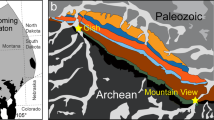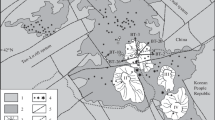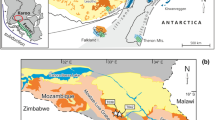Abstract—
Oxygen isotope composition was studied in 33 monomineralic fractions of olivine from plagioclase lherzolite, dunite, troctolite, and olivine gabbronorite of the Yoko-Dovyren layered massif. The δ18O values of the least altered rocks not contaminated with crustal materials range within 5.8 ± 0.2‰ (n = 27). These values for the dunite contaminated with carbonate material are notably higher and average at 6.2 ± 0.3‰. This is similar to characteristics of the Bushveld and Jinchuan mineralized complexes. Using the COMAGMAT-5 model, the temperatures of equilibrium of 98% crystals with late portions of the residual melts were evaluated at 1131–1266°C (1176 ± 34°C on average). These estimates are viewed as the closing temperatures of the cumulate systems with respect to the efficient exchange of 18O and 16O isotopes between olivine and mobile melt/fluid. For the uncontaminated systems, the δ18O values of the parental melt calculated using the modeled temperatures are 6.6 ± 0.2‰, and are 7.1 ± 0.3 ‰ for melts with signatures of crustal contamination. Such relations are consistent with insignificant (no more than a few percent) contamination of the parental magmas with carbonate materials from the host rocks.





Similar content being viewed by others
Notes
The LOI values were corrected by the formula (Lechler and Desilets, 1987) LOI* = LOI (original) + 0.11FeO, where the original value corresponds to the analytical values, and FeO is the total Fe concentration in the rock. It is therewith assumed that the oxidized Fe fraction in cumulates (particularly in an adcumulus rock) is low, and Fe2+ is completely oxidized in the process of annealing.
REFERENCES
Yu. V. Amelin, L. A. Neymark, E. Yu. Ritsk, and A. A. Nemchin, “Enriched Nd–Sr–Pb isotopic signatures in the Dovyren layered intrusion (eastern Siberia, Russia): evidence for contamination by ancient upper–crustal material,” Chem. Geol. 129, 39–69 (1996).
A. A. Ariskin and G. S. Barmina, “COMAGMAT: development of a magma crystallization model and its petrologic applications,” Geochem. Int. 42, S1–S157 (2004).
A. A. Ariskin, Yu. A. Kostitsyn, E. G. Konnikov, L. V. Danyushevsky, S. Meffre, G. S. Nikolaev, A. McNeill, E. V. Kislov, and D. A. Orsoev, “Geochronology of the Dovyren intrusive complex, Northwestern Baikal area, Russia, in the Neoproterozoic,” Geochem. Int. 51 (11), 859–875 (2013).
A. A. Ariskin, L. V. Danyushevsky, E. G. Konnikov, R. Maas, Yu. A. Kostitsyn, E. McNeill, S. Meffre, G. S. Nikolaev, and E. V. Kislov, “The Dovyren intrusive coplex (northern Baikal region, Russia): isotope–geochemical markers of contamination of parental magmas and extreme enrichment of the source,” Russ. Geol. Geophys. 56 (3), 411–434 (2015).
A. A. Ariskin, E. V. Kislov, L. V. Danyushevsky, G. S. Nikolaev, M. L. Fiorentini, S. Gilbert, K. Goemann, and A. Malyshev, “Cu–Ni–PGE fertility of the Yoko–Dovyren layered massif (Northern Transbaikalia, Russia): thermodynamic modeling of sulfide compositions in low mineralized dunite based on quantitative sulfide mineralogy,” Mineral. Deposita 51, 993–1011 (2016).
A. A. Ariskin, I. S. Fomin, E. V. Zharkova, A. A. Kadik, and G. S. Nikolaev, “Redox conditions during crystallization of ultramafic and gabbroic rocks of the Yoko–Dovyren Massif (based on the results of measurements of intrinsic oxygen fugacity of olivine),” Geochem. Int. 55 (7), 595–607 (2017).
A. A. Ariskin, K. A. Bychkov, G. S. Nikolaev, and G. S. Barmina, “The COMAGMAT-5: Modeling the effect of Fe–Ni sulfide immiscibility in crystallizing magmas and cumulates,” J. Petrol. 59, 283–298 (2018).
A. Ariskin, L. G. Danyushevsky, Nikolaev, E. Kislov, M. Fiorentini, A. McNeill, Yu. Kostitsyn, K. Goemann, S. Feig, and A. Malyshev, “The Dovyren Intrusive Complex (Southern Siberia, Russia): Insights into dynamics of an open magma chamber with implications for parental magma origin, composition, and Cu–Ni–PGE fertility,” Lithos 302, 242–262 (2018).
A. A. Ariskin, L. V. Danyushevsky, M. Fiorentinin, G. S. Nikolaev, E. V. Kislov, I. V. Pshenitsyn, V. O. Yapaskurt, and S. N. Sobolev, “Petrology, geochemistry, and origin of sulfide–bearing and PGE–mineralized troctolites from the Konnikov zone in the Yoko–Dovyren layered intrusion,” Russ. Geol. Geophys. 62 (5–6), 611–633 (2020).
V. P. Bushuev and R. S. Tarasov, The Kholodninskoe Sulfide–Base Metal Deposit. Report of the Kholodninskaya GRP for 1975–84 (Buryatgeologiya, Ulan–Ude, 1984) [in Russian].
T. Chacko and P. Deines, “Theoretical calculation of oxygen isotope fractionation factors in carbonate systems,” Geochim. Cosmochim. Acta. 72, 3642–3660 (2008).
C. I. Chalokwu, E. M. Ripley, and Y.-R. Park “Oxygen isotopic systematics of an open–system magma chamber: An example from the Freetown Layered Complex of Sierra Leone,” Geochim. Cosmochim. Acta 63 (5), 675–685 (1999).
R. N. Clayton and T. K. Mayeda, “The use of bromine pentafluoride in the extraction of oxygen from oxides and silicates for isotopic analysis,” Geochim. Cosmochim. Acta 27, 43–52 (1963).
T. Di Rocco, C. Freda, M. Gaeta, S. Mollo, and L. Dallai “Magma chambers emplaced in carbonate substrate: petrogenesis of skarn and cumulate rocks and implications for CO2 degassing in volcanic areas,” J. Petrol. 53, 2307–2332 (2012).
F. Di Stefano, S. Mollo, P. Scarlato, M. Nazzari, O. Bachmann, and M. Caruso, “Olivine compositional changes in primitive magmatic skarn environments: A reassessment of divalent cation partitioning models to quantify the effect of carbonate assimilation,” Lithos. 316–317, 104–121 (2018).
V. V. Distler and A. G. Stepin, “Low-sulfide PGE–bearing horizon of the Yoko–Dovyren layered ultramafic–mafic intrusion, Northern Baikal area,” Dokl. Akad. Nauk 328 (4), 498–501 (1993).
H. W. Eales and G. Costin “Crustally contaminated komatiite: primary source of the chromitites and Marginal, Lower, and Critical Zone magmas in a staging chamber beneath the Bushveld Complex,” Econ. Geol. 107, 645–665 (2012).
R. E. Ernst, M. A. Hamilton, U. Söderlund, J. A. Hanes, D. P. Gladkochub, A. V. Okrugin, T. Kolotilina, A. S. Mekhonoshin, W. Bleeker, A. N. LeCheminant, K. L. Buchan, K. R. Chamberlain, and A. N. Didenko, “Long-lived connection between southern Siberia and northern Laurentia in the Proterozoic,” Nature Geosci. 9, 464–469 (2016).
M. Gaeta, T. Di Rocco, and C. Freda, “Carbonate assimilation in open magmatic systems; the role of melt–bearing skarns and cumulate-forming processes,” J. Petrol. 50, 361–385 (2009).
A. I. Goncharenko, I. F. Gertner, and Yu. A. Fomin, “Evolution of oxygen isotope composition in olivines from the Yoko–Dovyren Pluton,” Geol. Geofiz. 12, 63–71 (1992).
T. Günther, K. M. Haase, M. Junge, T. Oberthür, D. Woelki, and S. Krumm, “Oxygen isotope and trace element compositions of platiniferous dunite pipes of the Bushveld Complex, South Africa – signals from a recycled mantle component?” Lithos. 310–311, 332–341 (2018).
S. A. Gurulev, Geology and Conditions of Formation of the Yoko–Dovyren Gabbro–Peridotite Massif (Nauka, Moscow, 1965) [in Russian].
C. Harris, J. J. M. Pronost, L. Ashwal, and R. G. Cawthorn, “Oxygen and hydrogen isotope stratigraphy of the Rustenburg Layered Suite, Bushveld Complex: constraints on crustal contamination,” J. Petrol. 46, 579–601 (2005).
E. Ito, W. M. White, and C. Gopel, “The O, Sr, and Pb isotope geochemistry of MORB,” Chem. Geol. 62, 157–176 (1987).
R. I. Kalamarides, “Kiglapait geochemistry VI: oxygen isotopes,” Geochim. Cosmochim. Acta 48, 1827–1836 (1984).
E. V. Kislov, Yoko–Dovyren Layered Massif (BNTs SO RAN, Ulan-Ude, 1998) [in Russian].
E. G. Konnikov, Precambrian Differentiated Ultramafic–Mafic Complexes of Transbaikalia (Nauka, Novosibirsk, 1986) [in Russian].
E. G. Konnikov, W. P. Meurer, S. S. Neruchev, E. M. Prasolov, E. V. Kislov, and D. A. Orsoev, “Fluid regime of platinum group elements (PGE) and gold-bearing reef formation in the Dovyren mafic–ultramafuc layered complex, eastern Siberia, Russia,” Mineral. Deposita 35, 526–532 (2000).
G. S. Krivoplyasov, A. A. Yaroshevsky, V. I. Ustinov, and V. P. Strizhov, “Redistribution of oxygen isotopes during interaction of magmatic systems with host rocks: evidence from the Yoko–Dovyren layered massif, northern Baikal area,” Proc. 9 th All–Union Symposium on Stable Isotopes in Geochemistry (GEOKHI AN SSSR, Moscow, 1982), pp. 134–136.
G. S. Krivoplyasov, A. A. Yaroshevsky, and V. I. Ustinov, “Oxygen isotope composition of rock–forming minerals of some differentiated trap sills and large layered intrusion: evidence from traps of the Norilsk district, Podkamennaya Tunguska River, and Yoko–Dovyren massif),” Proc. 10 th All–Union Symposium on Stable Isotopes in Geochemistry, Moscow, Russia, 1984 (GEOKHI RAS, Moscow, 1984), p. 233 [in Russian].
P. J. Lechler and M. O. Desilets, “A review of the use of loss on ignition as a measurement of total volatiles in whole–rock analysis, Chem. Geol. 63, 341–344 (1987).
I. Lee and E. M. Ripley, “Mineralogic and oxygen isotopic studies of open system magmatic processes in the South Kawishiwi Intrusion, Spruce Road area, Duluth Complex, Minnesota,” J. Petrol. 37, 1437–1461 (1996).
W. D. Maier, S.-J. Barnes, and B. T. Karykowski A chilled margin of komatiite and Mg–rich basaltic andesite in the western Bushveld Complex, South Africa. Contrib. Mineral. Petrol. 171, 1–22 (2016).
S. Mollo, M. Gaeta, C. Freda, T. Di Rocco, V. Misiti, and P. Scarlato, “Carbonate assimilation in magmas: A reappraisal based on experimental petrology,” Lithos 114, 503–514 (2010).
D. A. Orsoev, “Distribution of oxygen isotopes in rocks and minerals from the Critical Zone of the Ioko–Dovyren Pluton,” Geol. Ore Deposits 52, 543–550 (2010).
D. A. Orsoev, “Anorthosites of the low–sulfide platiniferous horizon (Reef I) in the Upper Riphean Yoko–Dovyren Massif (Northern Cisbaikalia): new data on the composition, PGE–Cu–Ni Mineralization, fluid regime, and formation conditions,” Geol. Ore Deposits 61 (4), 306–332 (2019).
D. A. Orsoev, E. V. Kislov, E. G. Konnikov, S. V. Kanakin, and A. B. Kulikova, “Distribution and compositional features of PGE–bearing horizons of the Yoko–Dovyren latered massif, Northern Baikal area,” Dokl. Akad. Nauk 340 (2), 225–228 (1995).
N. N. Pertsev, and L. I. Shabyllin, “Skarn, carbonate, and brucite xenoliths of the Yoko-Dovyren massif,” Contact Processes and Mineralization in the Gabbro–Peridotite Intrusions (Nauka, Moscow, 1979), pp. 85–96 [in Russian]
N. N. Pertsev, E. G. Konnikov, E. V. Kislov, D. A. Orsoev, and A. N. Nekrasov, “Merwinite–Facies magnesian skarns in xenoliths from dunite of the Dovyren layered intrusion,” Petrology 11 (5), 464–475 (2003).
G. V. Polyakov, N. D. Tolstykh, A. S. Mekhonoshin, A. E. Izokh, M. Yu. Podlipskii, D. A. Orsoev, and T. B. Kolotilina, “Ultramafic–mafic igneous complexes of the Precambrian East Siberian metallogenic province (southern framing of the Siberian craton): age, composition, origin, and ore potential,” Russ. Geol. Geophys. 54 (11), 1319–1331 (2013).
E. M. Ripley, A. Sarkar, and C. Li, “Mineralogic and stable isotope studies of hydrothermal alteration at the Jinchuan Ni–Cu deposit, China,” Econ. Geol. 100, 1349–1361 (2005).
E. Yu. Rytsk, V. S. Shalaev, N. G. Rizvanova, R. Sh. Krymskii, A. F. Makeev, and G. V. Rile, “The Olokit Zone of the Baikal fold region: new isotope-geochronological and petrogeochemical data,” Geotectonics 36 (1), 24–35 (2002).
Z. D. Sharp, “A laser-based microanalytical method for the in-situ determination of oxygen isotope ratios of silicates and oxides,” Geochim. Cosmochim. Acta 54, 1353–1357 (1990).
M. J. Spicuzza, J. W. Valley, M. J. Kohn, J. P. Girard, and A. M. Fouillac, “The rapid heating, defocused beam technique: a CO2–laser-based method for highly precise and accurate determination of δ18O values of quartz,” Chem. Geol. 144, 195–203 (1998).
E. M. Spiridonov, “Barium minerals barite and chlorine dominant ferrokinoshitalite \({\text{BaFe}}_{{\text{3}}}^{{{\text{2}} + }}\)[Cl2/Al2Si2O10] in plagioperidotites of the Yoko-Dovyren intrusion, northern Baikal Area: products of epigenetic low–grade metamorphism,” Geochem. Int. 57 (11), 1221–1229 (2019).
A. G. Stepin and A. I. Vlasenko, Results of Prospecting Works within the Yoko–Dovyren and Bezymyanny Mafic–Ultramafic Massifs. Report of the Dovyren Team for 1989–1993 (Buryatgeolkom, Nizhneangarsk, 1994) [in Russian].
Q. Tang, J. Jian Bao, Y. Dang, S. Ke, and Y. Zhao, “Mg–Sr–Nd isotopic constraints on the genesis of the giant Jinchuan Ni–Cu–(PGE) sulfide deposit, NW China,” Earth Planet. Sci. Let. 502, 221–230 (2018).
H. P. Taylor and S. Epstein, “Relation between 18O/16O ratios in coexisting minerals of igneous and metamorphic rocks. I Principles and experimental results,” Geol. Soc. Am. Bull. 73, 461–480 (1962).
H. P. Taylor, Jr. and S. Epstein, “O18/O16 ratios in rocks and coexisting minerals of the Skaergaard intrusion,” J. Petrol. 4, 51–74 (1963).
S. R. Taylor and S. M. McLennan, The Continental Crust: its Composition and Evolution (Blackwell Sci. Pub., Oxford, 1985).
V. I. Ustinov, A. A. Yaroshevksy, V. P. Striglov, and V. F. Sukhverkhov, “Oxygen isotope composition of rock–forming minerals of the Yoko-Dovyren dunite—troctolite–gabbronorite massif, Northern Baikal area,” Proc. 8 th All–Union Symposium on Stable Isotopes in Geochemistry (Moscow, 1980), pp. 56––58.
T. Wenzel, L. P. Baumgartner, G. E. Bruegman, E. G. Konnikov, and E. V. Kislov, “Partial melting and assimilation of dolomitic xenoliths by mafic magma: the Ioko–Dovyren intrusion (North Baikal Region, Russia),” J. Petrol. 43, 2049–2074 (2002).
A. H. Wilson, “A chill sequence to the Bushveld Complex: insight into the first stage of emplacement and implications for the parental magmas,” J. Petrol. 53, 1123–1168 (2012).
M. Zhang, S. L. Kamo, C. Li, P. Hu, and E. M. Ripley, “Precise U–Pb zirconbaddeleyite age of the Jinchuan sulfide ore-bearing ultramafic intrusion, western China,” Mineral. Deposita. 45, 3–9 (2010).
Z. F. Zhao and Y. F. Zheng, “Calculation of oxygen isotope fractionation in magmatic rocks,” Chem. Geol. 193, 59–80 (2003).
ACKNOWLEDGMENTS
The authors thank V.B. Polyakov (Institute of Experimental Mineralogy, Russian Academy of Sciences) for valuable comments on the manuscript and O.A. Lukanin (Vernadsky Institute of Geochemistry and Analytical Chemistry, Russian Academy of Sciences).
Funding
This study was supported by the Russian Science Foundation, project no. 16-17-10129. The oxygen isotope composition of olivine was studied under government-financed research project 0136-2019-0013 for the Institute of Geology of Ore Deposits, Petrography, Mineralogy and Geochemistry (IGEM), Russian Academy of Sciences. Olivine samples for this research were prepared under government-financed research project for the Vernadsky Institute of Geochemistry and Analytical Chemistry (GEOKhI), Russian Academy of Sciences.
Author information
Authors and Affiliations
Corresponding author
Additional information
Translated by E. Kurdyukov
Rights and permissions
About this article
Cite this article
Ariskin, A.A., Fomin, I.S., Dubinina, E.O. et al. Oxygen Isotope Composition in Olivine and Melts from Cumulates of the Yoko-Dovyren Layered Massif, Northern Transbaikalia, Russia. Geochem. Int. 59, 156–170 (2021). https://doi.org/10.1134/S0016702921020026
Received:
Revised:
Accepted:
Published:
Issue Date:
DOI: https://doi.org/10.1134/S0016702921020026




